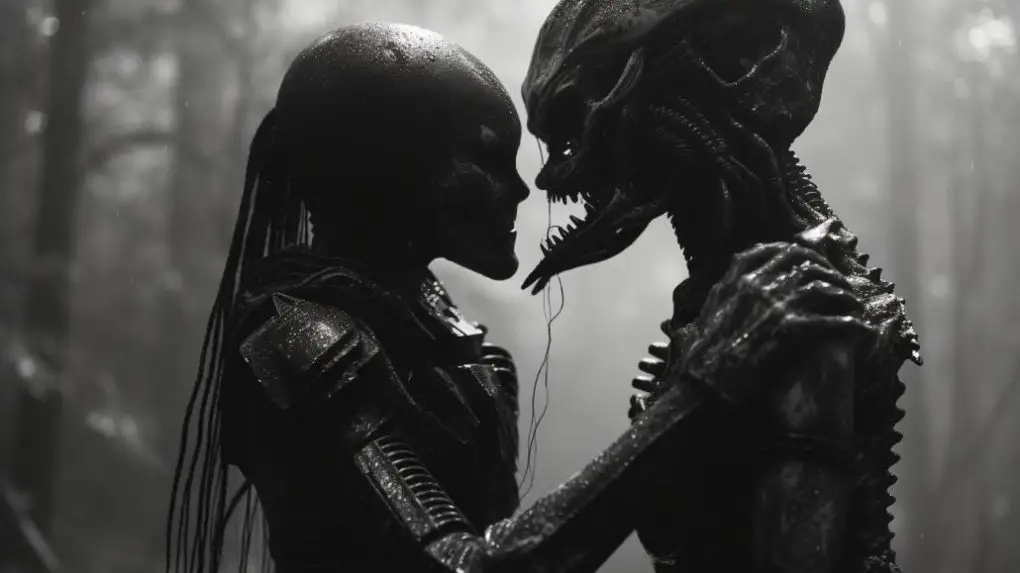Movies about aliens have been a mainstay in cinema history, captivating audiences with the idea of otherworldly beings, alien species, and the possibility of alien contact.
Since the birth of the sci-fi movie genre, filmgoers have been fascinated by stories about extraterrestrials and outer space, whether these involve peaceful first contact or more sinister alien invasions.
Exploring the Concept of Aliens in Cinema
From benevolent visitors like the extra-terrestrial in Spielberg’s classic to aggressive invaders as seen in “War of the Worlds,” where Tom Cruise stars, alien movies present a broad spectrum of intergalactic creatures and scenarios. Some films even explore the concept of alien life through shape-shifting aliens, like in the popular “Men in Black” series.
Don't miss Aliens In The Ocean – Discovering How Water May Harbour Signs Of Alien Life Forms
Unveiling the Allure of Alien Movies
The allure of alien movies lies in their ability to transport us to other planets and galaxies. Films like “Star Wars,” “Star Trek,” and “Guardians of the Galaxy” by director James Gunn have created entire universes teeming with diverse alien races, sparking our imaginations with their depictions of alien cultures and civilizations.
The Evolution of Alien Invasion Movies
Alien invasion movies have evolved considerably over the years. Earlier films like “The Day the Earth Stood Still” focused on single alien visitors, while more recent movies like “Independence Day,” featuring Jeff Goldblum, depict massive invasions where entire aliens invade Earth.
Top 5 Earliest Alien Movies
These include classic films like “War of the Worlds” (a quintessential alien invasion movie), “The Thing from Another World,” where an alien life-form crash-landed on Earth, “Mars Attacks!” directed by Tim Burton, and “Invasion of the Body Snatchers” – a film often considered one of the best political allegories in science fiction.
Breaking Down Alien Invasion: The Plot Mechanics
In alien invasion films, plots often revolve around a sudden discovery – crop circles, radio signals, or unidentified objects in the sky. Movies like “Signs” and “Close Encounters of the Third Kind” follow this pattern, leading to an alien invasion where humanity must fight back.
The Role of Protagonists in Alien Invasion Movies
Protagonists in alien invasion movies are often everyday people thrust into extraordinary circumstances, like Dakota Fanning and Tom Cruise’s characters in “War of the Worlds.”
Iconic Alien Characters in Film
From the friendly ET to the terrifying creature of the “Alien” franchise with Sigourney Weaver and David Bowie’s iconic role as an alien in “The Man Who Fell to Earth,” cinema is rich with memorable alien characters.
You may also like Crop Circles – Unraveling The Mystery Behind These Alleged Alien Ovals
The Technology of Invasion: Special Effects in Alien Movies
Alien Franchise: The original “Alien,” released in 1979, combined practical effects, miniatures, and H.R. Giger’s eerie designs to bring its nightmarish extraterrestrial to life. Giger’s bio-mechanical structure of the alien creature was groundbreaking, introducing a terrifying and strangely beautiful beast. Ridley Scott’s masterful lighting and camera work amplified these effects, creating an atmosphere of fear and tension.
The franchise pushed technological boundaries further with the sequel, “Aliens” (1986), directed by James Cameron. Cameron expanded the universe by introducing the Alien Queen, realized through puppetry and miniatures. “Alien” films also used animatronics, prosthetics, CGI, and motion capture in subsequent installments, continually pushing the envelope of visual effects.
Star Trek: Throughout its many iterations, “Star Trek” has used special effects to create its vision of the future and the various alien species that inhabit it. From the original series’ use of makeup and prosthetics to create aliens like the Vulcans and Klingons to the more recent movies’ use of CGI to create epic space battles and exotic alien worlds, “Star Trek” has often been at the forefront of special effects technology. In J.J. Abrams’ 2009 reboot and its sequels, cutting-edge CGI created spectacular visuals, including a highly detailed destruction of the planet Vulcan.
Avatar: James Cameron’s “Avatar” (2009) was a game-changer for special effects, employing advanced motion capture techniques to create the Na’vi, an alien race living on Pandora. Cameron and his team developed a new motion capture stage called “The Volume,” which allowed them to see the actors’ performances as their CGI characters in real time. This technology captured the actors’ full performances, including facial expressions, enabling the creation of realistic, emotive CGI characters.
In addition to the motion capture, “Avatar” also featured photorealistic CGI environments. The lush, bioluminescent forests of Pandora were entirely computer-generated but felt tangible and immersive, thanks to the painstaking attention to detail by the artists and technicians.
Moreover, “Avatar” is credited with reinvigorating the 3D movie industry. Cameron developed a new, more advanced 3D camera system that provided a more immersive viewing experience, bringing the world of Pandora to life.
These examples highlight how movies about aliens have continually pushed the boundaries of what’s possible in special effects, creating more believable alien creatures, more immersive alien worlds, and more engaging cinematic experiences.
Also read Aliens On Earth – Examining Stories Of An Alien Presence On This Planet
Cultural Impact of Alien Movies
Star Wars: George Lucas’ epic space opera is a cultural phenomenon, introducing memorable characters, complex themes, and rich alien worlds. The original trilogy, prequels, and sequels spawned an expanded universe of TV series like “The Mandalorian,” numerous books, toys, and games. Star Wars conventions gather thousands of fans annually, showing the power of this franchise.
Star Trek: Premiering as a TV series in 1966, Star Trek presented a future where humanity and various alien races coexist in an interstellar federation. Its impact is seen in multiple spin-off TV series, films, books, games, and merchandise. Its optimistic vision of the future and exploration of moral and social issues continue to resonate with audiences.
Deconstructing Classic Alien Invasion Movies
War of the Worlds: Based on H.G. Wells’ novel, this film (and its later Tom Cruise-starring remake) showcases the terrifying scenario of a hostile alien invasion. Its subtext often reflects societal fears of the time, from the Cold War anxieties in the 1953 version to post-9/11 tensions in the 2005 film.
Invasion of the Body Snatchers: This 1956 film is often read as a critique of McCarthy-era paranoia, with alien “pod people” replacing humans as a metaphor for fear of infiltration and loss of identity. Its enduring appeal lies in its ability to adapt to different socio-political contexts, as seen in multiple remakes.
Mars Attacks!: Tim Burton’s dark comedy pays homage to 1950s sci-fi B-movies and satirizes the genre. Its absurd depiction of Martians and their destructive antics serves as a humorous yet pointed critique of politics and media.
Alien Invasion Movies of the 21st Century
A Quiet Place: This film subverts typical alien invasion tropes by focusing on a family’s struggle for survival in a world overrun by sound-sensitive aliens. Emily Blunt’s performance and the movie’s emphasis on silence and sign language add suspense and emotional depth.
Arrival: Denis Villeneuve’s film profoundly explores communication and time. Amy Adams plays a linguist tasked with deciphering the language of newly arrived aliens. Rather than focusing on invasion, “Arrival” deals with our reaction to the unknown and challenges linear perceptions of time.
Related: Are Aliens Real? – Exploring The Possibility Of Extraterrestrial Life
The Scariest Alien Invasion Movies of All Time
Alien
“Alien” (1979), directed by Ridley Scott, is a seminal film that combines science fiction and horror in a tense and visceral narrative. The plot revolves around the commercial spaceship Nostromo, whose crew encounters a distress signal from a deserted planet and consequently faces a deadly extraterrestrial creature.
The creature, designed by Swiss artist H.R. Giger, is central to the film’s horror. Its life cycle—from egg to face-hugger to chest-burster to the titular Alien—is disturbing. The Alien is a biomechanical nightmare that moves with terrifying grace and kills without remorse.
The film’s setting amplifies the horror. The Nostromo, initially seen as a place of safety, becomes a claustrophobic trap. Its dark corridors and industrial design become as menacing as the Alien. The feeling of isolation in space, emphasized by the tagline “In space, no one can hear you scream,” adds to the fear and desperation.
Moreover, Scott’s meticulous direction, the slow-building tension, the realistic performances from the ensemble cast, including Sigourney Weaver in her star-making role as Ripley, and the haunting score by Jerry Goldsmith all contribute to a palpable sense of dread. The film’s success spawned a franchise, including sequels, prequels, crossovers, and countless imitators, demonstrating its enduring influence in cinema.
War of the Worlds
“War of the Worlds” has been adapted several times in various mediums, with two notable film versions: the 1953 original directed by Byron Haskin and produced by George Pal, and the 2005 remake directed by Steven Spielberg and starring Tom Cruise and Dakota Fanning.
The original 1953 film is a product of its time, reflecting Cold War anxieties. The Martians’ relentless and seemingly unstoppable invasion can be seen as a metaphor for fears of nuclear annihilation. The Martian war machines, with their distinctive manta ray design and heat-ray, are iconic images of an alien invasion. The film’s special effects were groundbreaking at the time and won an Academy Award.
The 2005 Spielberg version is a modern update, focusing on a divorced father trying to protect his children during the invasion. The film showcases Spielberg’s skill at creating suspense and spectacle. The alien tripods are immense and terrifying, emerging from the ground and devastating cities with their heat rays. The ferry scene and the attack on the protagonist’s car are particularly harrowing, showing the panic and chaos of the invasion.
In both films, the full-scale invasion by a technologically superior alien force results in widespread destruction and a sense of hopelessness. The Martians are not individuals but an implacable force, making them even more terrifying. The ending, in which [spoilers] the Martians are defeated not by human effort but by Earth’s bacteria, emphasizes our vulnerability in the face of such a threat.
Alien Invasions: The Comedy Aspect
Galaxy Quest: This affectionate parody of sci-fi TV shows like “Star Trek” features a cast of washed-up actors who get swept up in an actual alien conflict. The movie humorously explores the tropes and cliches of the genre while celebrating its appeal.
The World’s End: The final film in Edgar Wright’s “Cornetto Trilogy,” this film blends comedy, action, and sci-fi as a group of friends (led by Simon Pegg and Nick Frost) discover their hometown has been infiltrated by aliens during a pub crawl. The absurdity of the situation adds a comedic spin to the alien invasion premise.
The Most Thought-Provoking Alien Movies
Arrival: Besides being a notable alien invasion movie, “Arrival” is profoundly thought-provoking. The focus on language and communication underscores the importance of understanding and cooperation, not only with extraterrestrial beings but also among ourselves as a human race. Its non-linear storytelling structure also sparks reflections on the nature of time and memory.
Contact: Based on Carl Sagan’s novel, “Contact” explores the philosophical and spiritual implications of contact with extraterrestrial intelligence. Jodie Foster stars as a scientist who makes first contact, and the film skillfully combines hard science and speculation about the nature of the universe and our place in it.
Under the Skin: Scarlett Johansson plays an alien in human form in this haunting film, which deals with themes of identity, humanity, and the male gaze. Its ambiguous narrative and atmospheric style invite viewers to contemplate what it means to be human and how we perceive ourselves and others.
Looking Forward: The Future of Alien Invasion Movies
With evolving technology and storytelling techniques, the future of alien invasion movies looks promising. As we continue to explore our universe and ponder the existence of life on other planets, these films will undoubtedly continue to reflect our hopes and fears about what lies beyond our home planet.
Alien Invasion Movie Recommendations for Beginners
For those new to the genre, start with the classics such as “War of the Worlds,” “Invasion of the Body Snatchers,” and “Close Encounters of the Third Kind.” For a taste of modern cinema, try “War of the Worlds” starring Tom Cruise or “District 9,” a rare sequel that received critical acclaim.
Lesser-Known Alien Invasion Movies Worth Watching
Films like “Attack the Block,” “Monsters,” and “The Signal” may not be as well-known as “Star Wars” or the “Alien” franchise, but they offer fresh perspectives on alien invasions and are worth a watch.
Related Article Exploring the World of Cryptids – An In-Depth Look at Legendary Creatures
Conclusion: The Enduring Legacy of Alien Movies
From the early days of cinema to the present, movies about aliens have maintained an important place in our culture. Whether they make us laugh, scream, or contemplate our existence, these films continue to captivate audiences with their depictions of alien life.
Bonus: Must-Watch Alien Movies for Every Film Buff
Every film enthusiast should watch “Star Wars,” “Star Trek,” “ET: The Extra-Terrestrial,” “Close Encounters of the Third Kind,” “Mars Attacks!” and the “Alien” franchise. More recent films like “Arrival,” “A Quiet Place,” and “Guardians of the Galaxy” by James Gunn are also must-sees, showcasing the best of modern cinema’s portrayal of alien life.
Recommended Further Reading:
Auto Amazon Links: No products found.



